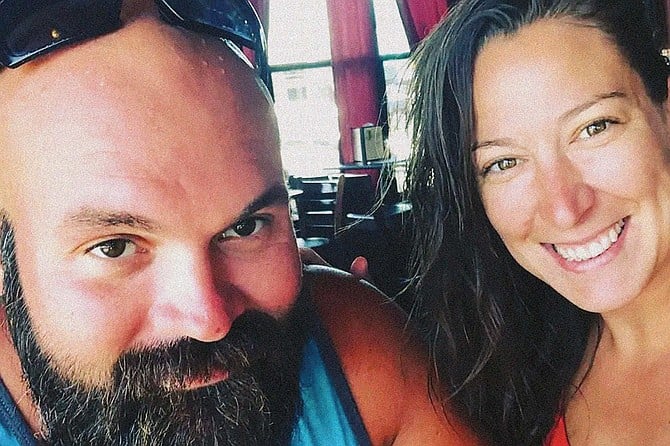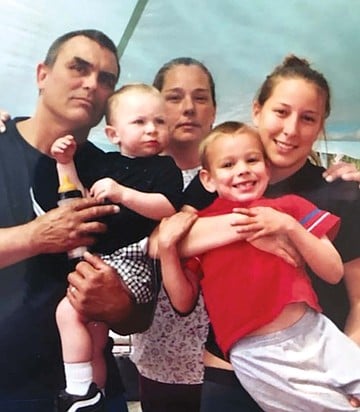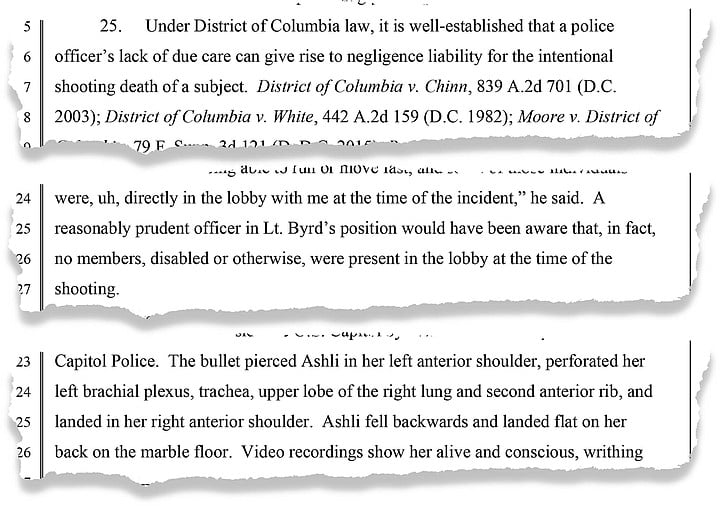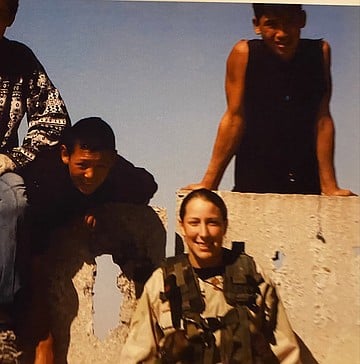 Facebook
Facebook
 X
X
 Instagram
Instagram
 TikTok
TikTok
 Youtube
Youtube

“It’s never gonna get easier, losing her. It just gets a little different, every day.”
— Aaron Babbitt, widower of Ashli Babbitt
On January 6 of 2023, Ashli Babbitt’s mother Mickie Witthoeft was arrested in Washington, D.C. for jaywalking. The 58-year-old had been in the city since the previous August, publicly supporting the protestors who had been arrested on various charges following their participation in a political protest exactly two years earlier. That protest has since been labeled an insurrection — an attempt to interrupt the workings of American democracy by interfering with the certification of the 2020 Presidential election results. Ms. Witthoeft told interviewers that she was there on behalf of the prisoners “who are wasting away in jail,” and also to memorialize the death of another one of the protestors: her daughter.

On January 6 of 2021, 35-year-old Air Force veteran Ashli Babbitt was shot while inside the U.S. Capitol building as she attempted to climb through a sidelight frame at the east entrance to the Speaker’s Lobby. She died shortly after being shot. Her husband Aaron, at home in Ocean Beach, learned of the shooting “through the news, through live television.” On January 5 of 2024, the conservative nonprofit Judicial Watch filed a $30 million lawsuit against the U.S. Government on behalf of Ashli’s estate and her widower Aaron, claiming assault, negligence, and wrongful death.
According to the lawsuit, Ashli Babbitt “did not go to Washington as part of a group or for any unlawful or nefarious purpose. Ashli loved her country and wanted to show her support for President Trump’s America First policies.” According to Aaron Babbitt in a television interview with FOX5, “I asked her not to go, but she wanted to see President Trump speak. She had never seen him speak live. She knew this was the last time she was gonna get a chance to. So.”
On January 6, Ashli attended the Save America rally just south of the White House to hear Trump speak. He told the crowd, “All of us here today do not want to see our election victory stolen by emboldened radical-left Democrats, which is what they’re doing…We will never give up, we will never concede. You don’t concede when there’s theft involved…We will stop the steal.” Later in the speech, he said, “Now it is up to Congress to confront this egregious assault on our democracy…We’re going to walk down to the Capitol…We have come to demand that Congress do the right thing and only count the electors who have been lawfully slated…I know that everyone here will soon be marching over to the Capitol building to peacefully and patriotically make your voices heard.”
After Trump finished speaking a little after 1 pm, Ashli joined the crowd marching down to the Capitol, about a mile and a half away. She can be seen in numerous videos, draping a red, white, and blue TRUMP flag like a cape over her diminutive frame as she walks. According to the lawsuit, “two undercover Metropolitan Police Department officers followed close behind Ashli as she climbed the stairs to the West Terrace.” She entered the Capitol on the Senate side of the building, encountering no resistance as she did so. Once inside, “Ashli encountered a female Capitol Police officer, who directed her to walk south toward the House side. Ashli complied.” At one point, she can be seen on video walking between velvet ropes along with other protestors — though their slow movements and calm demeanor makes them look more like bored tourists.

That changed when she reached the set of doors marked Speaker’s Lobby. There were three uniformed Capitol policemen standing in front of the doors. According to independent journalist Tayler Hansen, Ashli joked with the officers. But then a crowd formed in the hallway behind her. As the crowd became unruly and began to push toward the doors, the officers stepped aside and stood with their backs to the adjoining wall. Several people began beating on the doors and sidelights; the lawsuit names two of them as Chad Jones and Zachary Alam. Allegedly, Jones removed the glass from the right sidelight and placed it on the floor. Seemingly distressed by the escalating scene, Ashli can be heard on video yelling to an officer, “Call fucking help!”
According to the lawsuit, three minutes before Ashli got shot, there was a police radio call: “522. The crowd at the House main door is heading around to the glass doors on the rear now of the chambers. You need all units to go there and hold the glass.” Video from that day shows a Containment and Emergency Response Team hurrying up a staircase toward the scene. But they did not arrive before the three officers stepped aside and allowed the crowd to reach the doors. The team’s leader later told investigators, “I was thinking, ‘Why, why the fuck did they leave?’”
Tayler Hansen had been covering Antifa riots in Portland for the past year, and had decided to go to Washington on January 6, because he thought he would see more Antifa riots there. Instead, he found himself taking video of the chaos building in front of the Speaker’s Lobby doors. He says that Ashli was trying to calm the people beating on the doors, and even to prevent them from doing so. He says that his video shows Ashli taking hold of a man’s backpack with her right hand to pull him back from the doors, then punching the man with her left hand, knocking his glasses off his face. After seeing the video, Aaron Babbitt said, “I see a punch. A lot of people see a punch. I’ve gotten a lot of blowback, people saying, ‘There’s no way.’ But I know my wife’s a lefty. She’s a southpaw, and you can see his glasses pop off his face. So I see what everybody else sees.” In a 2022 interview with KUSI, Hansen said that he tried for more than a year to get the January 6 investigation committee to look at the video, but “it seems like they just don’t want to see it.”
But whatever else she did or did not do, at 2:44 pm, Ashli Babbitt definitely started to climb through the open sidelight into the Speaker’s Lobby. And as Hansen puts it, that’s when a man on the other side of the doors suddenly appeared and fired a shot at her. Three minutes after the shooting, at 2:47 p.m. the following radio call was recorded; the speaker is an unknown male: “Don’t know if this went out over the radio. We’ve got one civilian down with a GSW to the chest. They’re on the east side of the House lobby area. If we can have responding medical units respond from the west side of the House lobby we need it ASAP.”
According to the lawsuit, “The bullet pierced Ashli in her left anterior shoulder, perforated her left brachial plexus, trachea, upper lobe of the right lung and second anterior rib, and landed in her right anterior shoulder. Ashli fell backwards and landed flat on her back on the marble floor. Video recordings show her alive and conscious, writhing uncontrollably immediately after the shooting.” They also captured someone shouting, “You just murdered her!” But the autopsy report noted blood in her lungs, which indicated that she was alive and breathing after being shot, and concluded that she remained alive for at least several minutes. She was declared dead at Washington Hospital Center at 3:15 pm. The lawsuit states that the medical examiner determined that the manner of death was homicide.
* * *
Ashli Babbitt was born in Lakeside in 1985; she became the eldest of five children. She joined the Air Force in 2004, and made tours in Afghanistan and Iraq. According to the lawsuit, she was a military police officer who guarded high-value military assets and dignitaries in the Middle East. One of Aaron’s favorite photos of her shows her standing beside a four-star general he identifies as the CENT COM commander for Iraq at the time. “It was a pretty big deal,” he said. She became a reservist in 2008, and began serving in the Air National Guard in 2010. She was honorably discharged in 2016, with at least five medals, according to published reports.

In 2018, Ashli moved back to San Diego with Aaron. The two got married and bought a pool service business based in Spring Valley, but they lived in Ocean Beach. “She loved waking up every day and tackling the day,” recalled Aaron. “She just loved a challenge. Loved our life at the beach. Loved our dogs.” She self-identified as a libertarian, and voted at least once for Barack Obama. “She was an All-American girl,” said Aaron. “She loved serving her country. She loved moving back to California. She loved sports. She was my best friend, you know, and every day that goes by, there’s not a day that goes by that I don’t miss her.” (There are, of course, other things to know about Ashli Babbitt: the judicial orders forbidding her contact with Aaron’s former girlfriend, the interest in conspiracy-minded groups like QAnon, the famous January 5 tweet proclaiming, “Nothing can stop us…the storm is here and it is descending upon DC in less than 24 hours.” They are mentioned here lest this account be seen as ignoring them.)
* * *
Three months after the shooting, on April 14, 2021, the U.S. Justice Department declared that they had investigated and found “no evidence beyond a reasonable doubt that the officer” who shot Ashli “willfully committed a violation.” The announcement stated that Ashli was part of a “mob” that forced the three officers in front of the doors to “evacuate.” The DOJ declared they would not pursue any charges against the officer who shot Ashli. About this time, then-Speaker of the House Kevin McCarthy was seen on-camera answering a reporter’s question: “Do you think Ashli Babbitt was murdered, or do you think the police officer who shot her was doing his job?” McCarthy replied, “I think the police officer did his job.” The DOJ did not name the officer.
Ashli’s family, including her mother Micki Witthoeft and widower Aaron Babbitt, made public declarations of their disappointment, and said they would pursue legal action. Two weeks later, Ashli’s family retained Maryland lawyer Terrell Roberts. On April 29, attorney Roberts gave an interview to CNBC in which he said, “This is a clear case of excessive force,” and said the family would seek $10 million in damages from the U.S. Capitol Police and the unnamed officer who fatally shot Ashli. He also filed a FOIA request regarding the officer’s identity. When this failed to produce results, Roberts filed a lawsuit asking Washington D.C. police to disclose details and files regarding the officer who had shot Ashli.

Then, in August, just days after the U.S. Capitol Police’s Office of Professional Responsibility issued a public statement declaring the officer’s actions “consistent with the officer’s training,” the officer publicly revealed himself in an interview with NBC host Lester Holt. His name was Michael Leroy Byrd. He was a 53-year-old Lieutenant who had worked for the U.S. House of Representatives since 1998. He was also the U.S. Capitol Police incident commander for the House on January 6. He told Holt, “I believe I showed the utmost courage on January 6.”
The wrongful death lawsuit filed by Judicial Watch this month contains numerous quotations from Byrd’s interview with Holt, and takes issue with many of them. It notes that Byrd said he first heard the announcement that the Capitol had been breached at 2:12 p.m., and that “my rules of engagement never changed.” It notes that he said there were reports of “shots fired” and that he therefore took “a defensive stand and posture to protect myself.” It notes that he assessed that all persons inside the Capitol were an “imminent danger” to House members. It notes he described himself as “the last line of defense,” and said he was thinking, “If they get through that door, they’re into the House chamber and upon the members of Congress…I know that day I saved countless lives.” It notes that he claimed that there were 60 to 80 people in the House chamber (and that was just “members and their staff”), and that there were disabled persons with him in the lobby at the time of the shooting. And it notes that he claimed he was “trapped,” with no other way “to get out”
The lawsuit, on the other hand, claims that the doors on the west end of the chamber were still open and had been used to evacuate House members; that no members, disabled or otherwise, were in the lobby; that only six members were present in the chamber, and that those members were guarded by other armed officers. It argues that Ashli “posed no threat to the safety of anyone,” that the report of shots fired was false and immediately corrected by the original source — it was actually the sound of breaking glass.

The lawsuit notes Byrd’s alleged radio call within one minute after shooting Ashli, at 2:45 pm: “405B. We got shots fired in the lobby. We got shots fired in the lobby of the House chamber. Shots are being fired at us and we’re sh, uhh, prepared to fire back at them. We have guns drawn. Please don’t leave that end. Don’t leave that end.” And then, approximately 35 seconds later, Byrd made another radio call: “405B. We got an injured person. I believe that person was shot.” It also notes that Byrd granted that he shot Ashli before he saw her hands or assessed her intentions. He said he did give a warning, but he was wearing a facemask, and granted that “it is possible” that the people on the other side of the door did not hear him. It notes that he was not in uniform, and did not identify himself as a police officer.
The lawsuit argues that “The United States is liable for its employees’ acts or omissions,” and that “a police officer’s lack of due care can give rise to negligence liability.” It specifically alleges that Byrd’s training in shoot-don’t-shoot decisions was plainly deficient, and that he did not act as a reasonably prudent police officer, but used excessive force. The lawsuit claims that Byrd unholstered his weapon while he was still in a different room, and that he repeatedly tapped his finger on the pistol’s trigger for at least 14 seconds before he could even see Ashli. It claims that Byrd pointed his pistol in the direction of multiple persons, including uniformed police officers who were standing very near Ashli in the crowded area near the door. Then it goes on to argue that “in fact, Lt. Byrd had a reputation among peers for not being a good shot.”
It asserts that Byrd failed to meet or complete semiannual firearms qualifications, and had his police powers revoked on more than one occasion. In one incident, Byrd fired his weapon at juveniles who were driving off in his own car, which had been stolen; Byrd’s stray bullets hit nearby homes in the suburban area. That investigation found that Byrd’s use of force was not justified. (Further, Byrd had another, prior use-of-force matter that he appealed, and the Disciplinary Review Board found him “not guilty.”) The lawsuit alleges there are even more incidents in Byrd’s history — Judicial Watch hopes to learn more through discovery — which means the U.S. Capitol Police should have known that Byrd “would behave in a dangerous and/or incompetent manner.”

The suit goes on to argue that the government was negligent in retaining such an employee, noting that less than two years before Ashli was killed, on February 25, 2019, officer Byrd left his loaded Glock 22, the exact same pistol he used to kill Ashli, in a bathroom of the Capitol Visitor’s Center. Someone else found his pistol “during a routine security sweep later the same day.” (In his interview with Holt, Byrd called this “a terrible mistake.”) It concludes that the negligent supervision, discipline and retention of Byrd resulted in the predictable, foreseeable, and avoidable shooting of Ashli Babbitt.
* * *
After Byrd’s interview with Holt, Aaron Babbit and attorney Terrell Roberts appeared on Tucker Carlson’s FOX television show. Aaron said that he was “pissed off” when he heard Byrd claim that he was a victim — wiping a tear from his eye and saying that he had received death threats. “I been getting death threats since January 7,” Aaron said. “Two, three, five, ten a day. You know, and all I did was become a widower.” He also announced the creation of a GiveSendGo page to fund the family’s legal action, saying, “We need all the help we can get. It is the Goliath, you know, the David versus Goliath fight we got going on here.” He asked supporters to visit the family’s TwitterX page to keep up with developments, “because we are gonna have the weight of the U.S. government coming down, raining down on us.”
It was later reported that the GiveSendGo page Justice For Ashli Babbitt Legal Fund had collected $462,735. But in April of 2022, Terrell Roberts declared that he had withdrawn from the lawsuit. He also said that he intended to return the crowd-funded money. In May of 2022, California attorneys Rachel King and Dylan Gunzel filed papers in San Diego Superior Court to preserve the Ashli Babbitt family lawsuits and try to gain control of the GiveSendGo funds. The 2022 paperwork referred to the previous Complaint for assault and battery, negligence, and wrongful death, and stated that after Ashli’s death, widower Aaron was already given authorization by a local San Diego judge to administer Ashli’s estate. Most recently, the crowd-funded money has been described as “in limbo,” and still held by Roberts’ law firm.
Judicial Watch’s announcement of the lawsuit notes that it is “extensively investigating the events of January 6.” Michael Byrd is still with the Capitol Police. He was promoted from Lieutenant to Captain in August of 2023.


“It’s never gonna get easier, losing her. It just gets a little different, every day.”
— Aaron Babbitt, widower of Ashli Babbitt
On January 6 of 2023, Ashli Babbitt’s mother Mickie Witthoeft was arrested in Washington, D.C. for jaywalking. The 58-year-old had been in the city since the previous August, publicly supporting the protestors who had been arrested on various charges following their participation in a political protest exactly two years earlier. That protest has since been labeled an insurrection — an attempt to interrupt the workings of American democracy by interfering with the certification of the 2020 Presidential election results. Ms. Witthoeft told interviewers that she was there on behalf of the prisoners “who are wasting away in jail,” and also to memorialize the death of another one of the protestors: her daughter.

On January 6 of 2021, 35-year-old Air Force veteran Ashli Babbitt was shot while inside the U.S. Capitol building as she attempted to climb through a sidelight frame at the east entrance to the Speaker’s Lobby. She died shortly after being shot. Her husband Aaron, at home in Ocean Beach, learned of the shooting “through the news, through live television.” On January 5 of 2024, the conservative nonprofit Judicial Watch filed a $30 million lawsuit against the U.S. Government on behalf of Ashli’s estate and her widower Aaron, claiming assault, negligence, and wrongful death.
According to the lawsuit, Ashli Babbitt “did not go to Washington as part of a group or for any unlawful or nefarious purpose. Ashli loved her country and wanted to show her support for President Trump’s America First policies.” According to Aaron Babbitt in a television interview with FOX5, “I asked her not to go, but she wanted to see President Trump speak. She had never seen him speak live. She knew this was the last time she was gonna get a chance to. So.”
On January 6, Ashli attended the Save America rally just south of the White House to hear Trump speak. He told the crowd, “All of us here today do not want to see our election victory stolen by emboldened radical-left Democrats, which is what they’re doing…We will never give up, we will never concede. You don’t concede when there’s theft involved…We will stop the steal.” Later in the speech, he said, “Now it is up to Congress to confront this egregious assault on our democracy…We’re going to walk down to the Capitol…We have come to demand that Congress do the right thing and only count the electors who have been lawfully slated…I know that everyone here will soon be marching over to the Capitol building to peacefully and patriotically make your voices heard.”
After Trump finished speaking a little after 1 pm, Ashli joined the crowd marching down to the Capitol, about a mile and a half away. She can be seen in numerous videos, draping a red, white, and blue TRUMP flag like a cape over her diminutive frame as she walks. According to the lawsuit, “two undercover Metropolitan Police Department officers followed close behind Ashli as she climbed the stairs to the West Terrace.” She entered the Capitol on the Senate side of the building, encountering no resistance as she did so. Once inside, “Ashli encountered a female Capitol Police officer, who directed her to walk south toward the House side. Ashli complied.” At one point, she can be seen on video walking between velvet ropes along with other protestors — though their slow movements and calm demeanor makes them look more like bored tourists.

That changed when she reached the set of doors marked Speaker’s Lobby. There were three uniformed Capitol policemen standing in front of the doors. According to independent journalist Tayler Hansen, Ashli joked with the officers. But then a crowd formed in the hallway behind her. As the crowd became unruly and began to push toward the doors, the officers stepped aside and stood with their backs to the adjoining wall. Several people began beating on the doors and sidelights; the lawsuit names two of them as Chad Jones and Zachary Alam. Allegedly, Jones removed the glass from the right sidelight and placed it on the floor. Seemingly distressed by the escalating scene, Ashli can be heard on video yelling to an officer, “Call fucking help!”
According to the lawsuit, three minutes before Ashli got shot, there was a police radio call: “522. The crowd at the House main door is heading around to the glass doors on the rear now of the chambers. You need all units to go there and hold the glass.” Video from that day shows a Containment and Emergency Response Team hurrying up a staircase toward the scene. But they did not arrive before the three officers stepped aside and allowed the crowd to reach the doors. The team’s leader later told investigators, “I was thinking, ‘Why, why the fuck did they leave?’”
Tayler Hansen had been covering Antifa riots in Portland for the past year, and had decided to go to Washington on January 6, because he thought he would see more Antifa riots there. Instead, he found himself taking video of the chaos building in front of the Speaker’s Lobby doors. He says that Ashli was trying to calm the people beating on the doors, and even to prevent them from doing so. He says that his video shows Ashli taking hold of a man’s backpack with her right hand to pull him back from the doors, then punching the man with her left hand, knocking his glasses off his face. After seeing the video, Aaron Babbitt said, “I see a punch. A lot of people see a punch. I’ve gotten a lot of blowback, people saying, ‘There’s no way.’ But I know my wife’s a lefty. She’s a southpaw, and you can see his glasses pop off his face. So I see what everybody else sees.” In a 2022 interview with KUSI, Hansen said that he tried for more than a year to get the January 6 investigation committee to look at the video, but “it seems like they just don’t want to see it.”
But whatever else she did or did not do, at 2:44 pm, Ashli Babbitt definitely started to climb through the open sidelight into the Speaker’s Lobby. And as Hansen puts it, that’s when a man on the other side of the doors suddenly appeared and fired a shot at her. Three minutes after the shooting, at 2:47 p.m. the following radio call was recorded; the speaker is an unknown male: “Don’t know if this went out over the radio. We’ve got one civilian down with a GSW to the chest. They’re on the east side of the House lobby area. If we can have responding medical units respond from the west side of the House lobby we need it ASAP.”
According to the lawsuit, “The bullet pierced Ashli in her left anterior shoulder, perforated her left brachial plexus, trachea, upper lobe of the right lung and second anterior rib, and landed in her right anterior shoulder. Ashli fell backwards and landed flat on her back on the marble floor. Video recordings show her alive and conscious, writhing uncontrollably immediately after the shooting.” They also captured someone shouting, “You just murdered her!” But the autopsy report noted blood in her lungs, which indicated that she was alive and breathing after being shot, and concluded that she remained alive for at least several minutes. She was declared dead at Washington Hospital Center at 3:15 pm. The lawsuit states that the medical examiner determined that the manner of death was homicide.
* * *
Ashli Babbitt was born in Lakeside in 1985; she became the eldest of five children. She joined the Air Force in 2004, and made tours in Afghanistan and Iraq. According to the lawsuit, she was a military police officer who guarded high-value military assets and dignitaries in the Middle East. One of Aaron’s favorite photos of her shows her standing beside a four-star general he identifies as the CENT COM commander for Iraq at the time. “It was a pretty big deal,” he said. She became a reservist in 2008, and began serving in the Air National Guard in 2010. She was honorably discharged in 2016, with at least five medals, according to published reports.

In 2018, Ashli moved back to San Diego with Aaron. The two got married and bought a pool service business based in Spring Valley, but they lived in Ocean Beach. “She loved waking up every day and tackling the day,” recalled Aaron. “She just loved a challenge. Loved our life at the beach. Loved our dogs.” She self-identified as a libertarian, and voted at least once for Barack Obama. “She was an All-American girl,” said Aaron. “She loved serving her country. She loved moving back to California. She loved sports. She was my best friend, you know, and every day that goes by, there’s not a day that goes by that I don’t miss her.” (There are, of course, other things to know about Ashli Babbitt: the judicial orders forbidding her contact with Aaron’s former girlfriend, the interest in conspiracy-minded groups like QAnon, the famous January 5 tweet proclaiming, “Nothing can stop us…the storm is here and it is descending upon DC in less than 24 hours.” They are mentioned here lest this account be seen as ignoring them.)
* * *
Three months after the shooting, on April 14, 2021, the U.S. Justice Department declared that they had investigated and found “no evidence beyond a reasonable doubt that the officer” who shot Ashli “willfully committed a violation.” The announcement stated that Ashli was part of a “mob” that forced the three officers in front of the doors to “evacuate.” The DOJ declared they would not pursue any charges against the officer who shot Ashli. About this time, then-Speaker of the House Kevin McCarthy was seen on-camera answering a reporter’s question: “Do you think Ashli Babbitt was murdered, or do you think the police officer who shot her was doing his job?” McCarthy replied, “I think the police officer did his job.” The DOJ did not name the officer.
Ashli’s family, including her mother Micki Witthoeft and widower Aaron Babbitt, made public declarations of their disappointment, and said they would pursue legal action. Two weeks later, Ashli’s family retained Maryland lawyer Terrell Roberts. On April 29, attorney Roberts gave an interview to CNBC in which he said, “This is a clear case of excessive force,” and said the family would seek $10 million in damages from the U.S. Capitol Police and the unnamed officer who fatally shot Ashli. He also filed a FOIA request regarding the officer’s identity. When this failed to produce results, Roberts filed a lawsuit asking Washington D.C. police to disclose details and files regarding the officer who had shot Ashli.

Then, in August, just days after the U.S. Capitol Police’s Office of Professional Responsibility issued a public statement declaring the officer’s actions “consistent with the officer’s training,” the officer publicly revealed himself in an interview with NBC host Lester Holt. His name was Michael Leroy Byrd. He was a 53-year-old Lieutenant who had worked for the U.S. House of Representatives since 1998. He was also the U.S. Capitol Police incident commander for the House on January 6. He told Holt, “I believe I showed the utmost courage on January 6.”
The wrongful death lawsuit filed by Judicial Watch this month contains numerous quotations from Byrd’s interview with Holt, and takes issue with many of them. It notes that Byrd said he first heard the announcement that the Capitol had been breached at 2:12 p.m., and that “my rules of engagement never changed.” It notes that he said there were reports of “shots fired” and that he therefore took “a defensive stand and posture to protect myself.” It notes that he assessed that all persons inside the Capitol were an “imminent danger” to House members. It notes he described himself as “the last line of defense,” and said he was thinking, “If they get through that door, they’re into the House chamber and upon the members of Congress…I know that day I saved countless lives.” It notes that he claimed that there were 60 to 80 people in the House chamber (and that was just “members and their staff”), and that there were disabled persons with him in the lobby at the time of the shooting. And it notes that he claimed he was “trapped,” with no other way “to get out”
The lawsuit, on the other hand, claims that the doors on the west end of the chamber were still open and had been used to evacuate House members; that no members, disabled or otherwise, were in the lobby; that only six members were present in the chamber, and that those members were guarded by other armed officers. It argues that Ashli “posed no threat to the safety of anyone,” that the report of shots fired was false and immediately corrected by the original source — it was actually the sound of breaking glass.

The lawsuit notes Byrd’s alleged radio call within one minute after shooting Ashli, at 2:45 pm: “405B. We got shots fired in the lobby. We got shots fired in the lobby of the House chamber. Shots are being fired at us and we’re sh, uhh, prepared to fire back at them. We have guns drawn. Please don’t leave that end. Don’t leave that end.” And then, approximately 35 seconds later, Byrd made another radio call: “405B. We got an injured person. I believe that person was shot.” It also notes that Byrd granted that he shot Ashli before he saw her hands or assessed her intentions. He said he did give a warning, but he was wearing a facemask, and granted that “it is possible” that the people on the other side of the door did not hear him. It notes that he was not in uniform, and did not identify himself as a police officer.
The lawsuit argues that “The United States is liable for its employees’ acts or omissions,” and that “a police officer’s lack of due care can give rise to negligence liability.” It specifically alleges that Byrd’s training in shoot-don’t-shoot decisions was plainly deficient, and that he did not act as a reasonably prudent police officer, but used excessive force. The lawsuit claims that Byrd unholstered his weapon while he was still in a different room, and that he repeatedly tapped his finger on the pistol’s trigger for at least 14 seconds before he could even see Ashli. It claims that Byrd pointed his pistol in the direction of multiple persons, including uniformed police officers who were standing very near Ashli in the crowded area near the door. Then it goes on to argue that “in fact, Lt. Byrd had a reputation among peers for not being a good shot.”
It asserts that Byrd failed to meet or complete semiannual firearms qualifications, and had his police powers revoked on more than one occasion. In one incident, Byrd fired his weapon at juveniles who were driving off in his own car, which had been stolen; Byrd’s stray bullets hit nearby homes in the suburban area. That investigation found that Byrd’s use of force was not justified. (Further, Byrd had another, prior use-of-force matter that he appealed, and the Disciplinary Review Board found him “not guilty.”) The lawsuit alleges there are even more incidents in Byrd’s history — Judicial Watch hopes to learn more through discovery — which means the U.S. Capitol Police should have known that Byrd “would behave in a dangerous and/or incompetent manner.”

The suit goes on to argue that the government was negligent in retaining such an employee, noting that less than two years before Ashli was killed, on February 25, 2019, officer Byrd left his loaded Glock 22, the exact same pistol he used to kill Ashli, in a bathroom of the Capitol Visitor’s Center. Someone else found his pistol “during a routine security sweep later the same day.” (In his interview with Holt, Byrd called this “a terrible mistake.”) It concludes that the negligent supervision, discipline and retention of Byrd resulted in the predictable, foreseeable, and avoidable shooting of Ashli Babbitt.
* * *
After Byrd’s interview with Holt, Aaron Babbit and attorney Terrell Roberts appeared on Tucker Carlson’s FOX television show. Aaron said that he was “pissed off” when he heard Byrd claim that he was a victim — wiping a tear from his eye and saying that he had received death threats. “I been getting death threats since January 7,” Aaron said. “Two, three, five, ten a day. You know, and all I did was become a widower.” He also announced the creation of a GiveSendGo page to fund the family’s legal action, saying, “We need all the help we can get. It is the Goliath, you know, the David versus Goliath fight we got going on here.” He asked supporters to visit the family’s TwitterX page to keep up with developments, “because we are gonna have the weight of the U.S. government coming down, raining down on us.”
It was later reported that the GiveSendGo page Justice For Ashli Babbitt Legal Fund had collected $462,735. But in April of 2022, Terrell Roberts declared that he had withdrawn from the lawsuit. He also said that he intended to return the crowd-funded money. In May of 2022, California attorneys Rachel King and Dylan Gunzel filed papers in San Diego Superior Court to preserve the Ashli Babbitt family lawsuits and try to gain control of the GiveSendGo funds. The 2022 paperwork referred to the previous Complaint for assault and battery, negligence, and wrongful death, and stated that after Ashli’s death, widower Aaron was already given authorization by a local San Diego judge to administer Ashli’s estate. Most recently, the crowd-funded money has been described as “in limbo,” and still held by Roberts’ law firm.
Judicial Watch’s announcement of the lawsuit notes that it is “extensively investigating the events of January 6.” Michael Byrd is still with the Capitol Police. He was promoted from Lieutenant to Captain in August of 2023.